In-game ads represent an increasingly crucial revenue stream for games developers. This deltaDNA study, now in its fifth year, examines how F2P developers/publishers use - and feel about - ads in games.
The study
A total of 284 developers and publishers/studios completed the deltaDNA In-game Advertising Survey for 2019. The variance in respondents reflects the diversity of the mobile Free-to-Play (F2P) games industry, the impact of hyper-casual, and the increasing importance of the mid-tier. Check out these topline stats below:
• 94% of respondents use some form of in-game advertising
• A significant majority (62%) of our respondents produce casual games - the remaining 38% produce core games.
• The most popular genre was Match-3
• 10% of respondents have over 1,000,000 Daily Active Users (DAU)
What kind of ads do people use?
With an 82% usage rate among respondents, rewarded video is the most common ad format by a significant margin. The next most popular formats are interstitials and banner ads respectively, in line with previous years.
68% of respondents use more than one ad format within their games, up from 56% in 2018.
The most common combination of ads is a mix of rewarded video and interstitials. Increasingly, we see respondents using a wider variety of ad formats, with 33% using three or more different types of advertising, a rise from 20% the previous year.
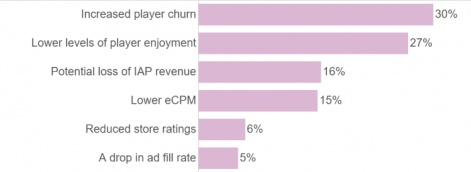
Generally, in-game ads are a little more likely to be used in casual or hyper-casual games in our sample. Playables and offer walls were the only types of advertising that were relatively more prevalent in core games compared to casual games.

Ad strategy
When it comes to strategy, the most noticeable difference between 2019 and 2018 is the number of respondents serving high numbers of ads in every session. Barely 20% of developers last year were willing to serve players with 5 or more ads, compared to 26% this year.
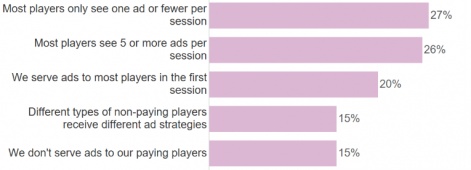
Looking at the split between casual and core games, it is clear that casual games have more aggressive ad strategies overall. In particular, casual games are much more likely to show ads in the first session. Core developers were less likely to take different ad strategies for different types of non-payers.
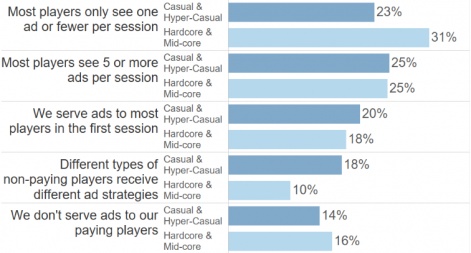
Perhaps unsurprisingly, the biggest worries for developers when using ads are the risks of players churning and, related to this, the risk of negatively impacting on players’ enjoyment.
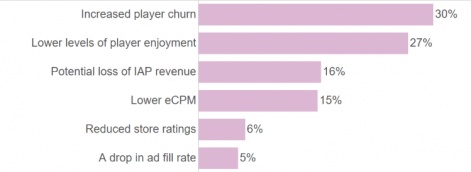
Looking at the breakdown by genre, in relative terms, churn is more concerning to developers of casual games. Conversely, core developers are more concerned for player enjoyment and possible loss of IAP revenues.

Overall, fears are dissipating with an increasing proportion of developers being unconcerned about the potential for ads to cannibalise IAP revenues.
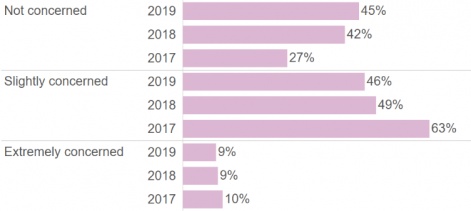
This pattern of greater concern over impact on IAP revenues amongst core developers is mirrored in responses to the specific question on IAP revenue cannibalization.
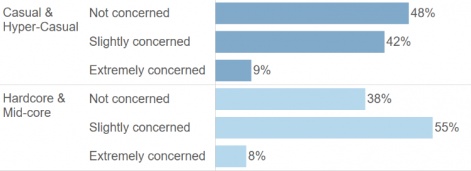
The open responses received regarding the most important factors for successfully monetizing tended to stress the importance of balance, to hit that “sweet spot” between generating revenues and maintaining player enjoyment. Several respondents commented on the positive aspects of advertising, from the player’s point of view, as a valuable source of game resources.
Ad revenue
For ads to be worthwhile, they need to deliver a significant revenue stream for developers. The chart below shows what fraction of our respondents’ revenues are accounted for by ads.
Among casual games, we observe an interesting split. While half of developers make less than 40% of their revenue from ads, 13% rely almost entirely on ads for their revenues.
For core developers, the steep decline in the proportions for whom ads generate less than 20% of revenues illustrates an increasing acceptance of ads as an important opportunity for monetization.
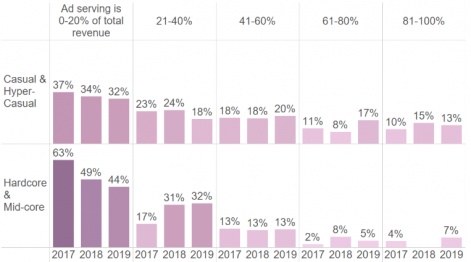
If you want to find out how developers approach their ad strategy, and how they really feel about ads, you can download the full results of the survey for FREE from the deltaDNA resource library.
Using data to manage the whole game economy, deltaDNA provides powerful CRM technology and expert consultancy for game-makers. They supply the tools and insights needed to optimize games, for individual players, in real time.
The deltaDNA analytics and player marketing platform is home to some of the games sector’s leading publishers and developers, including: Take-Two Interactive, Square Enix Montreal, and Bandai Namco Entertainment Europe.






















